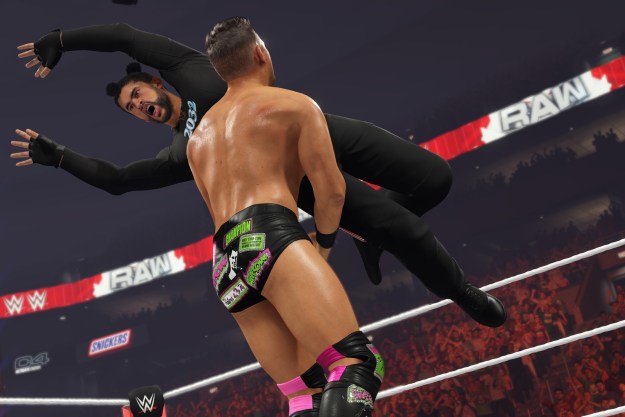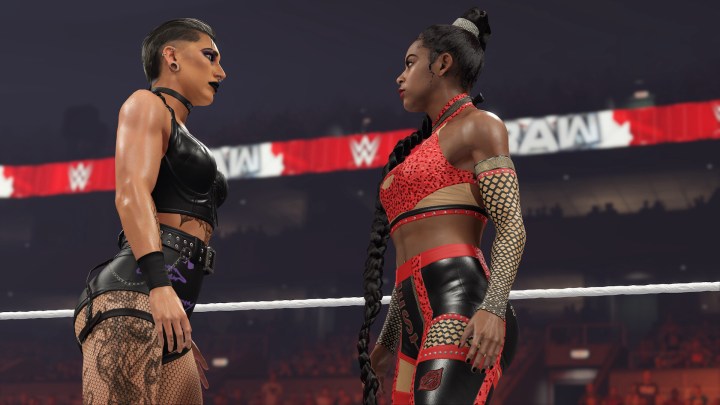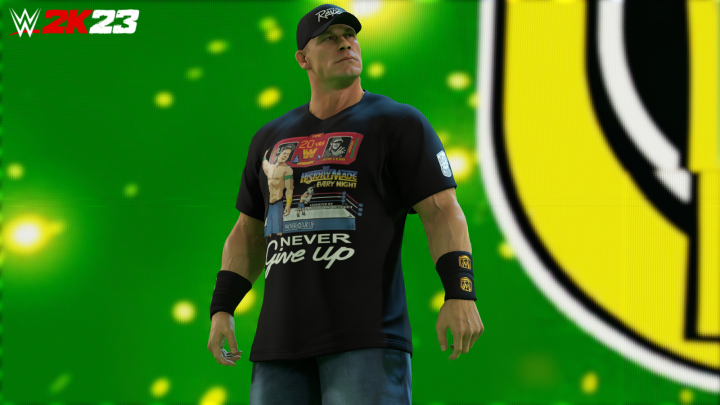

“WWE 2K23 is another successful chapter in the wrestling series’ comeback story, but the red flags of annualization are starting to appear already.”
Pros
- Core wrestling stands tall
- Roster is more current
- More MyUniverse options
- MyGM gets a huge upgrade
- Excellent creation suite
Cons
- Continued AI issues
- Mixed Showcase mode
- MyRise is a dud
If I were to compare WWE 2K23 to one wrestling move, it’d have to be the topé suicida. That maneuver sees a wrestler diving out of the ring through the ropes to take down their opponent on the outside. When hit with pinpoint accuracy, it’s a thing of beauty — though part of its appeal is that it truly looks dangerous. As a viewer, you’re always aware of just how wrong that could go with the slightest miscalculation. A foot getting hung up on an inch of rope could end in a broken neck. I’m always wowed when I watch someone pull the move off successfully, but I’m still left worrying about what could go wrong every single time.
That’s the position I find myself in with the latest entry in the WWE 2K franchise. Like last year’s standout release, the 2023 edition is another rock-solid chapter in the wrestling series’ comeback story. But as the 2K Games team returns to an annualized cadence — something that previously led to its catastrophic downfall — I find myself nervous anytime I encounter something that still feels off. Every janky animation or unfixed AI quirk feels like that one fateful inch between triumph and disaster. This year’s entry trends more towards the former, but I can’t keep myself from nervously watching some parts through my fingers.
WWE 2K23 continues its predecessor’s championship reign by doubling down on excellent features like its MyGM mode and a best-in-class creation suite. Some old frustrations still persist though, which can feel particularly worrying as the series zooms back into a yearly rhythm that isn’t kind to compounding problems. The series is in a healthy place for now, but it’ll need some continued cardio to avoid injury long term.
Added offense
In terms of its core wrestling, WWE 2K23 doesn’t make many major changes to its predecessor. The controls are the same, revolving around strikes, grapples, and combos that allow matches to unfold at a fluid pace. I’m still impressed by how well the series is able to capture the improvisational nature of wrestling so well, making big moves and moments feel like they naturally flow out of fights. At their best moments, matches can truly match the shock and drama of the real thing.
You really feel like a wrestler weighing how to spend their stamina.
While the basics are unchanged, there are some tweaks here that have a bigger impact on battles than one might expect. Kickouts, for example, now have players completing a timing-based, joystick-flicking minigame instead of simply button mashing. It’s a small change, but one that makes every pinfall attempt much more tense. Not only that, but it provides a good visual indicator of how weak an opponent is, as the timing window gets narrower depending on how weak they are.
Meter management plays a much bigger role in matches now too. In addition to a three-tick finisher bar, players also have a blue bar that has multiple purposes. When fully filled up, it can be spent to perform a signature move. However, chunks of it can also be spent to get off the ground quicker, perform a possum attack while laid out, trigger an equipped special ability (like a low blow), and more. That adds a lot more potential for in-ring storytelling, while also requiring some smart on-the-fly decision-making and resource management. You really feel like a wrestler weighing how to spend their stamina.
While I enjoy a lot of the changes here, I’m also of two minds about them. In the series’ current iteration, there’s a major emphasis on following on-screen button prompts. Performing a finisher, grabbing a rope to break a pin, reversing an attack, mounting a comeback sequence, suckering an opponent into a possum pin … all of those are essentially quick-time events. Though I don’t mind much, I do worry that it’s taking away some of the series’ pick-up-and-play appeal. I can’t imagine having to explain every single on-screen prompt to a friend during a match and having them retain them.

In general, this year’s edition seems like it’s playing a little more toward the fans who already know the games inside and out. Reversals in particular feel a little harder to execute, with split-second timing windows. That’s great news for hypercompetitive players who want to treat it as an esport, but it can be a little frustrating as more of a mid-card jobber. I find myself preemptively mashing face buttons a lot more this year, trying to anticipate reversal opportunities instead of reacting to them naturally.
Some of this can be tweaked with settings, but all of that leaves me a little curious about the series’ future as a casual game. The more it moves into full simulation mode, the more demanding it becomes. I imagine that 2K22 might stick around as my “goof around with friends” game while 2K23 is the one I’ll play solo.
Building momentum
Beyond the changes to its core wrestling, just about every feature of WWE 2K23 has gotten some form of overhaul. Some of these work, whereas others expose some of the series’ current limitations. The list of highlights starts with its superstar roster, which is a major upgrade over last year’s depressingly outdated installment. The new game feels more reflective of the current WWE product, with only a few leftover gimmicks (Piper Niven is still Doudrop, sadly) and roster omissions. That makes it much easier to “play along” with the current product.

That’s exactly what I’ve been doing in my favorite modes. In the sandbox MyUniverse, I’m currently booking my own Sami Zayn babyface run. At the moment, he’s on an impressive Intercontinental Title run that’s given him five-star feuds with Santos Escobar and The Miz. What I love about the newly retooled mode is how many options it gives me to build those stories. I can book rivalries or demand title matches, but I can also trigger some pre and post-match angles that add some heat to an angle. In my series with Escobar, I had matches where he jumped me before the bell or sucker-punched me during a sportsmanlike opening handshake. Those shake-ups keep me coming back, as every match or feud can feel totally distinct.
What I’m most excited about is the complete overhaul of MyGM included here. In WWE 2K22, the newly introduced mode was almost exclusively how I played it. The management simulator allowed me to book my own wrestling show and watch it like a TV show. It was a brilliant addition, but an incredibly limited one too. But 2K23 gives that mode the supersizing it deserves, adding a wealth of new options that take it out of its prototype phase.
The true main event here is once again the 2K series’ best-in-class creation suite.
The new version lets players book way more match types, have a full set of champions (including a mid-card title and two sets of tag belts), and continue their run once they finish the “end goal.” There are still some annoyances here and there, like not being able to book a triple threat as a championship match, but I’m thrilled by the scope increase of it overall. I’m already running one heck of a promotion with multilayered feuds that weave through singles matches, multi-man bouts, and tag team battles.
Of course, the true main event here is once again the 2K series’ best-in-class creation suite. Not much has changed there, but I’m always impressed all over again whenever I test a new entry. I spent a good hour creating the weirdest monster I could, going as far as to craft a custom entrance that had a whole arena booing as he sexily strutted down the ramp to presidential fanfare. At this point, the series could totally drop the ball one year and still be recommendable so long as that feature remains intact. It’s a reliable finishing move that must be protected at all costs.
Stubborn as a heel
While I’ve really latched onto those modes, others aspects haven’t fared quite as well. That’s both due to some continued quirks in the simulation and some stubborn design choices that frustrate me even more after last year’s entry. My biggest disappointment here comes from the AI, which doesn’t feel like it’s been improved all too well. Tag team matches are still a nightmare (and mixed tag matches are even worse), with computer-controller partners breaking up almost every pinfall before the referee can even count to one. Those refs aren’t free of sin either, as they have a tendency to randomly delay their count or struggle to even get into position. The same thing I said last year holds true here: singles matches are the best and things get progressively worse the more bodies that enter the ring.
I love what 2K Games is going for with its storytelling, but it’s all brought down by overall presentation.
Certain modes haven’t seen the improvements I was hoping for either, though not for lack of trying. This year’s MyShowcase is a step up on paper, letting players beat the crap out of John Cena through the ages. It’s an ingenious concept compared to the mode’s usual implementation. The narrative premise means that players get to play as a bunch of different wrestlers rather than playing as Cena for a dozen matches. It’s a little more narratively compelling too, as it tells the story of a humble legend reflecting on his (scripted) failures.
What drives me up a wall though, is that the mode still asks players to execute specific moves without showing prompts on screen. Match flow is constantly interrupted as I pop into a menu to figure out how the heck I do a corkscrew leg drop. That problem is actually made worse by the multi-wrestler premise, as I can’t build up a moveset knowledge base over time and execute attacks without checking the combo list. I’m constantly in menus, which takes away from the whole “playable documentary” feeling the game aims to deliver. Ultimately, 2K Games’ refusal to just put the necessary combos on-screen comes off as frustratingly stubborn.

MyRise is a bit of a disappointment too, and one that really shows the danger the series faces long term as its problems compound. Like MyShowcase, I love the idea here in theory. Rather than telling a generic “zero-to-hero” story, the single-player story mode takes some creative narrative swings across two separate campaigns. The Lock, for instance, tells the story of an established athlete who’s brought into WWE as “the next big thing.” It’s a fun way to invert 2K’s usual wrestling stories by having players deal with the pressure of expectations. Similarly, The Legacy follows a second-generation wrestler who’s out to prove she’s more than just a nepotism baby after a disastrous debut.
I love what 2K Games is going for with its storytelling, but it’s all brought down by overall presentation. Much of its story is told through bland character models dryly spitting out loads of flat dialogue between matches. To make matters worse, it’s littered with long loading screens – even on PS5 – that give it a frustrating start-and-stop pace. When watching those problems intersect with some of the lingering AI issues and bugs is where I begin to worry.

At this point, the 2K team has its hands full. The team is trying to juggle five core modes, improving and expanding each one every year. That’s on top of managing the creation suite, adding match types like WarGames, making new wrestlers, fixing bugs, plotting out multiple DLC waves, balancing online play, and more. It seems impossible for an annual release, and MyRise is where I can start to see the impact of split priorities. With its increased narrative ambitions comes a sloppy mode that I fear is on the edge of collapse. Meanwhile, an awful lot of work has gone into buffing up the microtransaction-loaded MyFactions.
I’m positive on WWE 2K23 overall, as there’s enough great content I can sink my teeth into, but I hope 2K Games can keep its momentum up against mounting odds. I’ve already encountered more bugs this time than I did in 2K22, which has me worried that a series this big can only go downhill on a yearly cadence. It happened to Madden, it happened to Call of Duty, and it happened to the WWE series in the 2010s. Until then, I’ll continue to root for the robust wrestling simulator as it continues its Drew McIntyre-like comeback story. I just hope it can retain the hype after it reaches the mountaintop. That’s the real battle.
WWE 2K23 was reviewed on PlayStation 5.
Editors’ Recommendations


